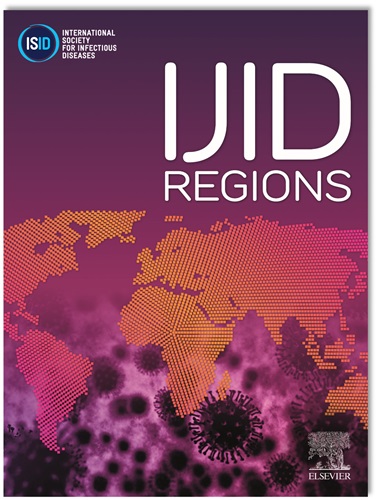Challenges in Managing Multidrug-Resistant Gram-Negative Infections
IF 4.8
2区 医学
Q1 INFECTIOUS DISEASES
引用次数: 0
Abstract
Introduction
Multidrug-resistant Gram-negative infections pose significant challenges, particularly in developing countries where carbapenem-resistant organisms, such as Enterobacterales, Acinetobacter baumannii, and Pseudomonas aeruginosa (CRE, CRAB, and CRPA), are prevalent. The World Health Organization has highlighted these as priority pathogens due to their high rates of resistance and the urgent need for new antibiotics to treat them. This talk will address the challenges in managing these infections and explore current treatment options through instructive case scenarios and literature reviews.
Methods
We performed a comprehensive review of current literature on the global epidemiology and management of carbapenem-resistant infections, particularly with polymyxin-based therapies and newer beta-lactam/beta-lactamase inhibitor (BL/BLI) combinations. The molecular mechanisms responsible for carbapenem-resistant infections, the uniqueness of different pathogens, and the distribution of resistance across geographical locations were examined. Clinical outcomes from recent studies and trials were analyzed to assess the effectiveness and limitations of available treatment options to help clinicians choose appropriate treatment strategies.
Results
In 2019, there were 4.95 million deaths related to global antimicrobial resistance (AMR), and it was projected that by 2050, there will be 10 million annual deaths attributable to AMR. Developing nations experience a disproportionately higher burden of AMR-related deaths. In India alone, 297,000 deaths in 2019 were attributable to AMR, with 1,042,500 deaths associated with it. Most AMR-associated deaths were due to three priority pathogens: Escherichia coli (152,700 deaths), Klebsiella pneumoniae (123,200 deaths), and Acinetobacter baumannii (103,500 deaths). ESBL resistance among Enterobacterales was around 80%, with carbapenem resistance rates of 40-50% and 70-80% among Klebsiella and Acinetobacter strains, respectively. Although treatment with Polymyxin-based therapies is a mainstay in developing countries, it presents significant challenges due to dosing issues, poor drug concentration, and nephrotoxicity. Newer BL/BLIs, such as ceftazidime-avibactam and meropenem-vaborbactam, are promising alternatives but come with poor availability and high costs. They are also less effective against metallo-beta-lactamase-producing organisms like NDM, which are common in South and Southeast Asia.
Discussion
The management of carbapenem-resistant infections varies significantly between developed and developing countries. Despite their limitations, polymyxin-based therapies are commonly prescribed in developing countries due to their accessibility and low cost. Newer BL/BLIs show promise but have limitations, such as cost, availability and efficacy. The efficacy of these treatment options is further complicated by the presence of additional resistance mechanisms, such as PBP3 inserts in CRE and MBLs in CRPA and CRAB.
Conclusion
The fight against multidrug-resistant Gram-negative infections requires a multifaceted approach. Advancements in antimicrobials and BL/BLI combinations are constrained by regional resistance patterns and economic factors. Addressing antimicrobial resistance in developing countries necessitates responsible prescription of antibiotics, stringent antimicrobial stewardship programs, regulated antibiotic usage, robust infection control practices, and the development of new agents to curb the spread of resistance.
治疗耐多药革兰氏阴性菌感染面临的挑战
多重耐药革兰氏阴性感染构成了重大挑战,特别是在碳青霉烯耐药生物,如肠杆菌、鲍曼不动杆菌和铜绿假单胞菌(CRE、CRAB和CRPA)普遍存在的发展中国家。世界卫生组织强调这些是重点病原体,因为它们的耐药率很高,迫切需要新的抗生素来治疗它们。本次演讲将通过有指导意义的案例和文献综述来解决管理这些感染的挑战,并探讨当前的治疗方案。方法:我们对目前关于碳青霉烯耐药感染的全球流行病学和管理的文献进行了全面回顾,特别是基于多粘菌素的治疗和较新的β -内酰胺/ β -内酰胺酶抑制剂(BL/BLI)联合治疗。研究了碳青霉烯耐药感染的分子机制、不同病原体的独特性以及耐药在不同地理位置的分布。分析了近期研究和试验的临床结果,以评估可用治疗方案的有效性和局限性,以帮助临床医生选择适当的治疗策略。结果2019年,全球有495万人死于抗生素耐药性(AMR),预计到2050年,每年将有1000万人死于抗生素耐药性。发展中国家与抗菌素耐药性相关的死亡负担高得不成比例。仅在印度,2019年就有29.7万人死于抗菌素耐药性,其中104.25万人死于抗菌素耐药性。大多数与抗菌素耐药性相关的死亡是由三种主要病原体造成的:大肠杆菌(152700例死亡)、肺炎克雷伯菌(123200例死亡)和鲍曼不动杆菌(103500例死亡)。肠杆菌对ESBL的耐药率在80%左右,克雷伯菌和不动杆菌对碳青霉烯的耐药率分别为40-50%和70-80%。尽管以多粘菌素为基础的治疗方法是发展中国家的主要治疗方法,但由于剂量问题、药物浓度差和肾毒性,它提出了重大挑战。较新的BL/ bli,如头孢他啶-阿维巴坦和美罗培宁-瓦波巴坦,是有希望的替代品,但其可得性差且成本高。它们对产生金属-内酰胺酶的生物(如NDM)的效果也较差,NDM在南亚和东南亚很常见。碳青霉烯耐药感染的管理在发达国家和发展中国家之间差别很大。尽管多粘菌素有其局限性,但由于其可及性和低成本,在发展中国家通常开多粘菌素疗法。较新的BL/ bli显示出前景,但存在成本、可用性和功效等限制。这些治疗方案的疗效由于其他耐药机制的存在而进一步复杂化,例如CRE中的PBP3插入物和CRPA和CRAB中的mbl。结论防治多重耐药革兰氏阴性菌感染需要采取多方面的措施。抗微生物药物和BL/BLI组合的进展受到区域耐药模式和经济因素的制约。解决发展中国家的抗菌素耐药性问题需要负责任的抗生素处方、严格的抗菌素管理规划、规范抗生素使用、强有力的感染控制措施以及开发遏制耐药性传播的新药。
本文章由计算机程序翻译,如有差异,请以英文原文为准。
求助全文
约1分钟内获得全文
求助全文
来源期刊
CiteScore
18.90
自引率
2.40%
发文量
1020
审稿时长
30 days
期刊介绍:
International Journal of Infectious Diseases (IJID)
Publisher: International Society for Infectious Diseases
Publication Frequency: Monthly
Type: Peer-reviewed, Open Access
Scope:
Publishes original clinical and laboratory-based research.
Reports clinical trials, reviews, and some case reports.
Focuses on epidemiology, clinical diagnosis, treatment, and control of infectious diseases.
Emphasizes diseases common in under-resourced countries.

 求助内容:
求助内容: 应助结果提醒方式:
应助结果提醒方式:


